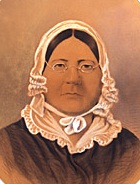Star-Spangled Banner may refer to:

The national flag of the United States, often referred to as the American flag or the U.S. flag, consists of thirteen horizontal stripes, alternating red and white, with a blue rectangle in the canton bearing fifty small, white, five-pointed stars arranged in nine offset horizontal rows, where rows of six stars alternate with rows of five stars. The 50 stars on the flag represent the 50 U.S. states, and the 13 stripes represent the thirteen British colonies that won independence from Great Britain in the American Revolutionary War.

"The Star-Spangled Banner" is the national anthem of the United States. The lyrics come from the "Defence of Fort M'Henry", a poem written by American lawyer Francis Scott Key on September 14, 1814, after he witnessed the bombardment of Fort McHenry by the British Royal Navy during the Battle of Baltimore in the War of 1812. Key was inspired by the large U.S. flag, with 15 stars and 15 stripes, known as the Star-Spangled Banner, flying triumphantly above the fort after the battle.

Fort McHenry is a historical American coastal pentagonal bastion fort on Locust Point, now a neighborhood of Baltimore, Maryland. It is best known for its role in the War of 1812, when it successfully defended Baltimore Harbor from an attack by the British navy from Chesapeake Bay on September 13–14, 1814.
"Home of the Brave" is the ending phrase from the United States national anthem "The Star-Spangled Banner". It may refer to:

The Star-Spangled Banner Flag House, formerly the Flag House & Star-Spangled Banner Museum, is a museum located in the Jonestown/Old Town and adjacent to Little Italy neighborhoods of eastern downtown Baltimore, Maryland, United States.

Mary Pickersgill was the maker of the Star-Spangled Banner hoisted over Fort McHenry during the Battle of Baltimore in the War of 1812. The daughter of another noted flag maker, Rebecca Young, Pickersgill learned her craft from her mother, and in 1813 she was commissioned by Major George Armistead to make a flag for Baltimore's Fort McHenry that was so large that the British would have no difficulty seeing it from a great distance. The flag was installed in August 1813 and, during the Battle of Baltimore a year later, Francis Scott Key could see the flag while negotiating a prisoner exchange aboard a British vessel and was inspired to pen the words that became the United States National Anthem in 1931.
Red flag may refer to:

"Columbia, the Gem of the Ocean" is an American patriotic song which was popular in the U.S. during the 19th and early 20th centuries. Composed c. 1843, it was long used as an unofficial national anthem of the United States, in competition with other songs. Under the title "Three Cheers for the Red, White, and Blue," the song is mentioned in Chapter IX of MacKinlay Kantor's Pulitzer Prize-winning novel Andersonville (1955). It was also featured in the 1957 musical The Music Man. In 1969, "Columbia, the Gem of the Ocean" was the music performed by a U.S. Navy Band embarked aboard USS Hornet as one of the ship's helicopters recovered the Apollo 11 astronauts from their capsule named Columbia after a splashdown in the Pacific Ocean.
National symbols of the United States are the symbols used to represent the United States of America.

"The Star Spangled Banner" is a charity single recorded by American singer Whitney Houston to raise funds for soldiers and families of those involved in the Persian Gulf War. Written by Francis Scott Key and John Stafford Smith, "The Star-Spangled Banner" is the national anthem of the United States. The musical arrangement for Houston's rendition was by conductor John Clayton. The recording was produced by music coordinator Rickey Minor, along with Houston herself. The recording was included in the 2014 CD/DVD release, Whitney Houston Live: Her Greatest Performances and the US edition of the 2000 release, Whitney: The Greatest Hits.
"Nuestro Himno" is a Spanish-language version of the United States national anthem, "The Star-Spangled Banner". The debut of the translation came amid a growing controversy over immigration in the United States.

The Star-Spangled Banner, or the Great Garrison Flag, was the garrison flag that flew over Fort McHenry in Baltimore Harbor during the naval portion of the Battle of Baltimore during the War of 1812. It is on exhibit at the National Museum of American History, Smithsonian Institution. Seeing the flag flying over Fort McHenry on the morning of September 14, 1814, after the battle ended, Francis Scott Key was inspired to write the poem "Defence of Fort M'Henry". These words were written by Key and set to the tune of "To Anacreon in Heaven", a popular song at the time, by John Stafford Smith. In 1931 the song became the national anthem of the United States.
Land of the Free may refer to:
There are several museums named War of 1812 museum:
"O Say Can You See" is the incipit of the national anthem of the United States, "The Star-Spangled Banner".
By the Dawn's Early Light and similar phrases could refer to:
What So Proudly We Hailed and similar phrases could refer to:
Twilight's Last Gleaming is a 1977 German-American film directed by Robert Aldrich.
Through the Perilous Fight and similar phrases could refer to:
Gave Proof Through the Night and similar phrases could refer to: